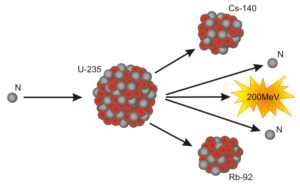A Nuclear Letdown
I loved going through early physics education. Every day we learned remarkable things like induction, Newton’s Laws, and the Conservation of Angular Momentum. When we got to nuclear power, I thought we were in for a real treat. Little did I know, that nuclear power would result in my greatest disappointment in physics, to date.
The basis of nuclear power is a heavy, unstable atom. In this context, “unstable” means that the atom is not in an energetically favorable state and tends to change into something else. It does not mean that the change will occur immediately, just that it eventually will… especially with a little kick. In some cases, such an unstable atom may have too many, or too few, neutrons in its nucleus. Eventually the atom splits apart (called fission), producing two new atoms and a LOT of excess energy in the form of light and heat.

So far, so good… right? You might be thinking we capture that energy using wires in direct contact with the nuclear material – I know I sure did. Well, that’s incorrect. The reaction’s too hot, and most wires we might use would melt. So how do we get electrical energy out of a reaction that’s too hot to interact with? Steam. Heat from the nuclear reaction causes a huge vat of water to boil into steam; the steam rises and spins big turbines; the big turbines change mechanical energy into electrical energy. It’s virtually the same mechanism as a coal plant. Biggest. Disappointment. Ever!
Food TidbitI don’t hate on steam, just its damaging effect on my romanticized preconception of nuclear power. Steam is an incredibly important cooking tool, and this article brings to mind its use in the melting of chocolate. Sure, you can melt chocolate in a simple pot on the stove, but you run a high risk of burning the chocolate, or losing smoothness in the result. Melting chocolate in a double-boiler will result in nice, even heating and allows you to temper the chocolate more effectively. Essentially, a double-boiler is a pot with some water in it, and a bowl placed on top of that. The water boils into steam, and the steam heats the bowl uniformly. Viola!

 Next Post
Next Post